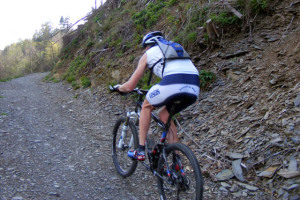 If you’ve ever wanted a more fun way to work out than heading to gym classes, this article is going to help you rediscover something awesome! That’s right; riding a bike is an incredibly way to work out and relieve stress. Cycling has always been a super exciting way to stay fit and in shape, and if you’re anything like most people, you probably rode a bike as a kid and then not so much after learning how to drive. But as the saying goes, once you get back on a bike, you won’t be able to get back off for long! Well, that may not be exactly how the saying goes, but after reading this article, you’ll definitely be thinking that it is.
If you’ve ever wanted a more fun way to work out than heading to gym classes, this article is going to help you rediscover something awesome! That’s right; riding a bike is an incredibly way to work out and relieve stress. Cycling has always been a super exciting way to stay fit and in shape, and if you’re anything like most people, you probably rode a bike as a kid and then not so much after learning how to drive. But as the saying goes, once you get back on a bike, you won’t be able to get back off for long! Well, that may not be exactly how the saying goes, but after reading this article, you’ll definitely be thinking that it is.
Click Here To See The Best Selling Beginner Mountain Bike
This article is designed to help you get into biking as an adult beginner or a real beginner. We’ll talk all about the benefits of biking, and let you know everything you need to keep an eye out for when shopping for a bike. Then, we’re going to look at some individual reviews of actual bikes! These reviews are designed to appeal to a wide audience, and you should find something that suits you and your needs perfectly. By the time you finish reading, you’ll be a pro at knowing what to look for in a mountain bike! And, just like we showed you in our beginner road bike article, we’ll be really thorough about all aspects of the bike you need to pay attention to.
Before we begin talking about what features you’ll be looking for in a new bike, it’s important to remember that biking is a sport. Even though it’s often used as a practical mode of transportation, it can still be dangerous to ride. Even if you’re just using your bike to commute to work, it’s definite that you’ll need a helmet. And since you’re planning to ride mountain bikes, this is even more crucial. Mountain biking is an intense and adrenaline-fueled sport, and even if you’ve been riding bikes for years, it’s likely that you’ll still take a fall or two. If you’re going to be doing really intense trails, it would be beneficial to take a class at a local bike shop or sporting goods store to learn about how riding will impact you and your body. Even though the best bikes have great shock absorption, it’s still going to take a little bit of time to get used to the sensation of landing on both tires.
What To Know Before Buying Your First Mountain Bike
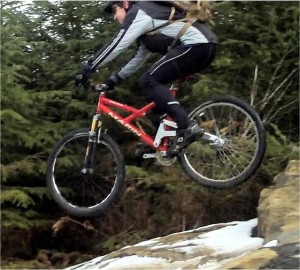 Before we even begin to talk bikes, we’re going to talk about where you’ll need to be shopping. First of all, don’t think about going to Walmart or Target. Even though both of those stores are known for providing great value and savings to their customers, you shouldn’t look for a bike there. First of all, it’s likely that you’ll be buying a generalized model made in China or Taiwan, known for their inferior products. You want to buy a bike that’s designed exactly for the type of mountain trails you’ll be riding it on, and unfortunately that kind of bike is going to be impossible to find at Walmart. On the positive side, you’ll be relieved to learn that even though you’re not shopping at a big box value store, you still won’t be spending an absurd amount of money. It’s a good idea to become familiar with your local bike shops, and to think about purchasing a bike there. In addition to being able to offer a wider array of merchandise at reasonable prices, the staff is going to be extremely familiar with bikes, and they’ll be able to guide you if you have any questions after reading this article.
Before we even begin to talk bikes, we’re going to talk about where you’ll need to be shopping. First of all, don’t think about going to Walmart or Target. Even though both of those stores are known for providing great value and savings to their customers, you shouldn’t look for a bike there. First of all, it’s likely that you’ll be buying a generalized model made in China or Taiwan, known for their inferior products. You want to buy a bike that’s designed exactly for the type of mountain trails you’ll be riding it on, and unfortunately that kind of bike is going to be impossible to find at Walmart. On the positive side, you’ll be relieved to learn that even though you’re not shopping at a big box value store, you still won’t be spending an absurd amount of money. It’s a good idea to become familiar with your local bike shops, and to think about purchasing a bike there. In addition to being able to offer a wider array of merchandise at reasonable prices, the staff is going to be extremely familiar with bikes, and they’ll be able to guide you if you have any questions after reading this article.
When it comes to bikes, there are a few things that are non-negotiable. Before you start out, think about what your riding style is going to be. Your riding style means how frequently and how intensely you’ll be riding. It’s one thing to buy a mountain bike for rides around the trails behind your neighborhood; it’s quite another to plan a vacation out west that involves biking down steep and treacherous terrain. And while frequency of course means how often you’re planning to ride, there are a few other things you should consider. Are you planning to ride alone, or with friends? Are you planning to keep this to a ‘guys weekend’ type of wild riding, or is there a chance you’ll be pulling a trailer with kids behind you? Determining the answers to these questions can go a long way with helping to find you a perfect mountain bike, so don’t brush them off. If you’re generally unsure about how often you’ll be riding, it’s best to pick a general trail bike. If you’re extremely in shape and enjoy vigorous workouts, you may find yourself preferring a hardtail or full-suspension bike. It’s also important to note that if you suffer from joint pain or arthritis (or if you just prefer a smoother ride—hey, no judgment!) it would be a good idea to have a bike with full-suspension, as that reduces pressure on your joints.
It’s important to thank your lucky stars that you live in the modern age! Until the 1980s, all mountain bikes had no suspension! Think about how painful that would be! Luckily, today you have many choices. You can either opt for no suspension, hardtail, or full. Think of hardtail as kind of a blend between full suspension and no suspension. They only have one fork, attached to the front wheel, which is meant to reduce hand and arm fatigue while riding. Hardtail suspension bikes also improve your control and steering as you navigate rough surfaces. Basic suspension forks function by using a steel coil spring; high-end bikes use an air-sprung fork instead. It’s likely that everyone reading this article will be just fine with a basic suspension fork; save the advanced technology for when you’re more advanced!
What Trail Types Will You Be Riding?
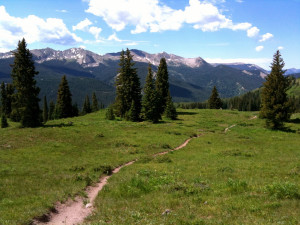 Before shopping for a mountain bike, think about the types of trails you’re going to be riding. Depending on where you live in the country, the soil is bound to be different than it is everywhere else. If you’re in the Mid-Atlantic, you’ll have a lot of messy clay soil to live with; in the South, you’ll have a lot of sand that could lead to frequent wipeouts and falls. Most of the mountain bikes we’ll be looking at today are general trail bikes, which is likely what you’ll wind up purchasing. However if you’re eager to move past the beginner stage, there are also all-mountain bikes, which have stronger frames and longer suspension. These are for more advanced riders on difficult terrain, so if you’re at all unsure, it’s best to stick with a general trail bike.
Before shopping for a mountain bike, think about the types of trails you’re going to be riding. Depending on where you live in the country, the soil is bound to be different than it is everywhere else. If you’re in the Mid-Atlantic, you’ll have a lot of messy clay soil to live with; in the South, you’ll have a lot of sand that could lead to frequent wipeouts and falls. Most of the mountain bikes we’ll be looking at today are general trail bikes, which is likely what you’ll wind up purchasing. However if you’re eager to move past the beginner stage, there are also all-mountain bikes, which have stronger frames and longer suspension. These are for more advanced riders on difficult terrain, so if you’re at all unsure, it’s best to stick with a general trail bike.
Of course, not all mountain bikes are general trail bikes or all-mountain. There are also cross country bikes, freeride bikes, and dirt bikes! Cross-country bikes are best for, you guessed it, riding cross-country. The emphasis in these bikes is in their ability to cover a lot of ground in a short time, ascend well, and corner well. Cross country bikes are not well-suited for heavy trails, so make sure that if that’s what you go for, you won’t be putting too much strain on the steel frame. Freeride bikes are specifically designed for getting you downhill as quickly as possible. They’re specially built in order to soak up as much shock and damage from rocks and terrain as possible, but they’re not especially aerodynamic, and they’re not good for riding uphill. Often, you’ll see ski lifts at ski resorts carrying these bikes back up to the top, because they’re almost impossible to manage. And finally, dirt bikes. Most dirt bikes are geared towards adolescent riders, but it is definitely possible to find one for an adult who is interested in finding their ‘inner child’ once again. Dirt bikes often have to be ridden on special courses and tracks, unless you live in a desert terrain. They’re fun, but watch out! Dirtbikes can be incredibly dangerous.
Keep Wheel Size In Mind
Lastly, we’re going to look at wheel size. The standard size for mountain bike wheels used to be 26”, but now it’s not uncommon to see 27.5” or 29” wheels. Larger wheels have become very popular because even though it takes more effort from you to accelerate, they provide a great momentum once you actually get going, and they handle trail obstacles with much more ease. However, shorter riders are not going to find 29” wheels comfortable, so it’s important to pay attention to your height. Bike fit is incredibly important, so don’t brush off the wheel size.
Bike Brands
This last part isn’t mandatory, but it would do you well to listen. It’s a great idea to look for a bike brand that really stands behind their product. Even though you’re not going to be spending more money than you can handle on a bike, you want to make sure that you’re getting a quality product. Sometimes, just as you can hurt yourself biking, your bike can also need an occasional fix or repair. Plus, if you’re spending a lot of time biking, you’re definitely going to need the occasional tune-up. While it’s a great idea to get familiar with your local bike shop and the services they provide, sometimes brands of bikes will go above and beyond providing customer service to their clients. A solid warranty is a good start; just in case you get a ‘lemon,’ you’ll want the company to stand behind with product with pride. If you’re unsure, talk to the people working at your local bike shop. They’ll definitely have some good ideas about which brands are notorious for outstanding service, and what types of things you should look for to be covered.
Accessories?
After you buy your bike, you’re going to want to purchase a few accessories along with it. Aside from the incredibly important and obvious helmet, it’s a good idea to think about a seat cushion or light-reflecting technology for nighttime rides. Since you’ll be burning quite a few calories, having a bike with a water bottle would definitely work out in your favor. Plus, if you’re really going to be hitting some rocky trails, it’s not a bad idea to consider a small toolkit or multipurpose tool with you. You never know when you’re going to have to fix a tire puncture in the middle of the woods with no cell phone reception!
Another quick note before we get started: you may want to consider heading to your bike shop for assembly after you receive your new bike. Even though it can be pretty simple in most cases to assemble a bike, it’s not something you want to risk screwing up. Since you’re a beginning rider, it’s unlikely that you’ve handled this kind of repair work before, so it’s best to leave it to the pros. Most bike shops will perform this service for $50 or $100, and as a bonus, it’s likely you’ll learn a few tips while you’re watching them assemble your new bike.
Best Mountain Bikes For Beginners + Reviews
Now, we’re going to look at a few of the best beginner mountain bikes available to you! Remember, these reviews are written from an objective standpoint. This article wasn’t designed to sell you something, but rather improve your knowledge so you can make the most informed purchase possible. We’ll detail some of the best features of each of the below bikes, and we’ll even include user review information from real riders! That way, you’ll know you’re hearing the truth, and not just advertising. If you have any specific questions about biking, it would be a good idea to comb through the reviews and see if anyone had a similar problem. You might be surprised at the kind of info you can uncover just by doing a little research! And if you don’t see any bikes that you absolutely love, don’t worry. This article is meant to serve as a guide, not a bible. Take the opportunity to finally visit your local bike shop; with a list of questions, brands, and products, the employees will have a much better idea of where to start helping you.
Impasse Dual Full Suspension Bicycle (29-Inch) by Mongoose
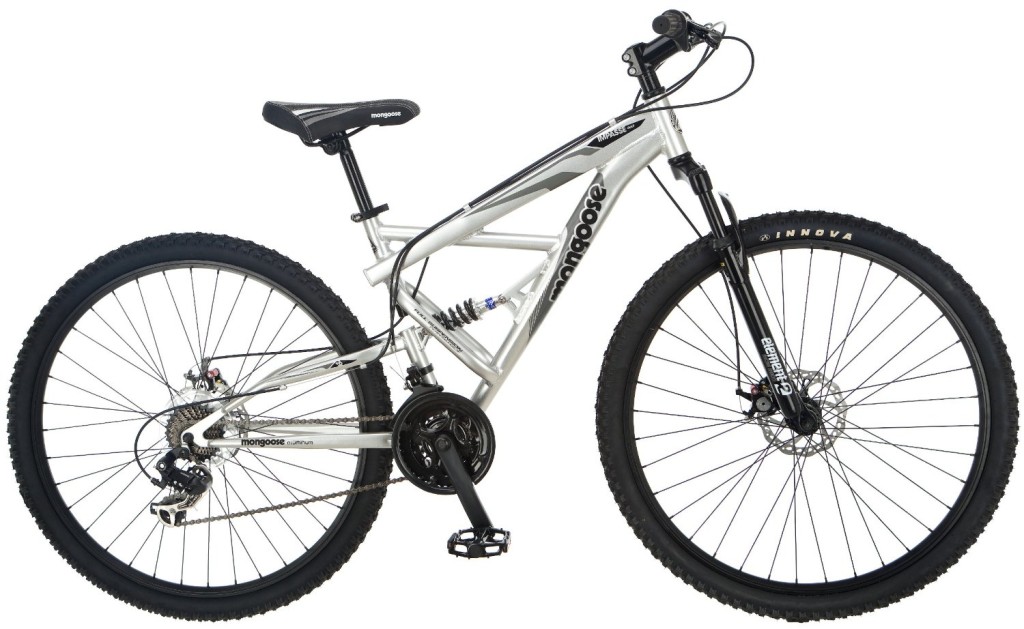
Click here to see the Impasse Best Price
If you were immediately sold on a full suspension bike after reading the description, this Impasse mountain bike by Mongoose will thrill you! It features an aluminum suspension frame for maximum comfort and performance, and an element suspension fork for extra smooth rides, all the time. You’re bound to stay in control with the Impasse bike by Mongoose! This bike has 21 speeds for lots of fun times riding on the trail—you’ll be fully equipped to handle any kind of terrain. The Impasse is a bestselling bike, and users really seem to love it. This bike weighs 46lbs, which is about average for a beginner mountain bike, and features 29” wheels. So while the Impasse is definitely one of the best beginner mountain bikes available, it’s definitely not for those who are a little on the shorter side. Users report that this is a great bike for someone young, or for someone who is just starting out and beginning to ride. It won’t break the bank, but don’t expect the Impasse to hold up to heavy years of riding trails. If you’re thinking about casual mountain use, this would be the perfect bike for you! With this bike, a lot of users mention the need for a seat upgrade, so if you plan to ride for more than a few miles at a time, it would be a great idea to get a new seat or at least a seat cover. Check your local bike shop for recommendations, and happy trails!
Recoil Trail Full Suspension Mountain Bike with 27.5-Inch Wheels by Diamondback Bicycles
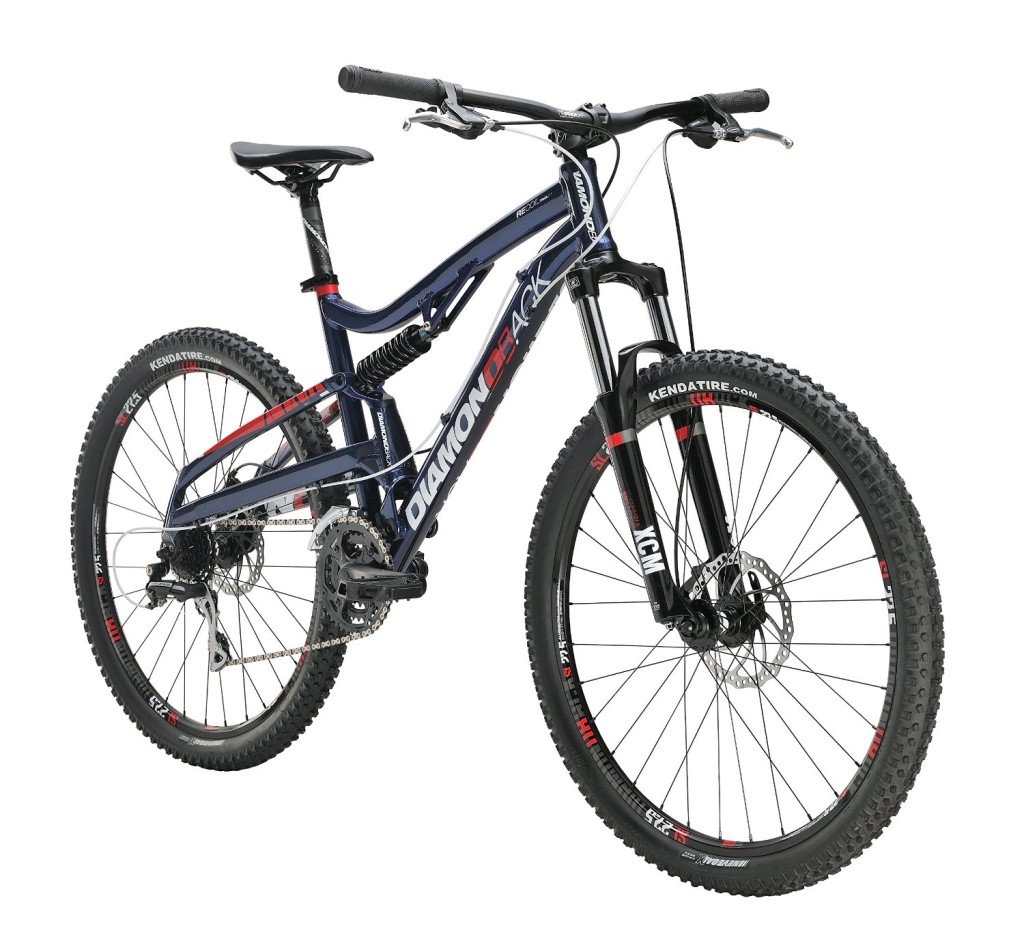
Click here to see the Recoil Trail Best Price
If the idea of a full suspension bike really appealed to you, but you’re not tall enough for a 29” bike, consider this Recoil Trail bike by Diamondback. Diamondback is a really respected brand in mountain bikes, and this bike is one of the more affordable offerings. If you’re someone who plans to ride frequently and for many years, this would be a great way to ease into the waters! Users of this bike report really loving the traction and suspension, saying that it provides an incredibly smooth ride that holds up well and isn’t too bouncy. The brakes also work very well, and the bike comes in at just 34lbs, which is very light! One user did mention that they had to buy new metal pedals for riding this bike in the mountains and on the trails, but aside from that, this bike is mostly ready to go right out of the box! If you want a high quality bike from a brand that loves to stand behind their products, check out the Recoil Trail bike from Diamondback! You really won’t find a better bike for the price, and it’s guaranteed to last for years.
High Timber Men’s 18 Mountain Bike, 18-Inch/Medium, White by Schwinn
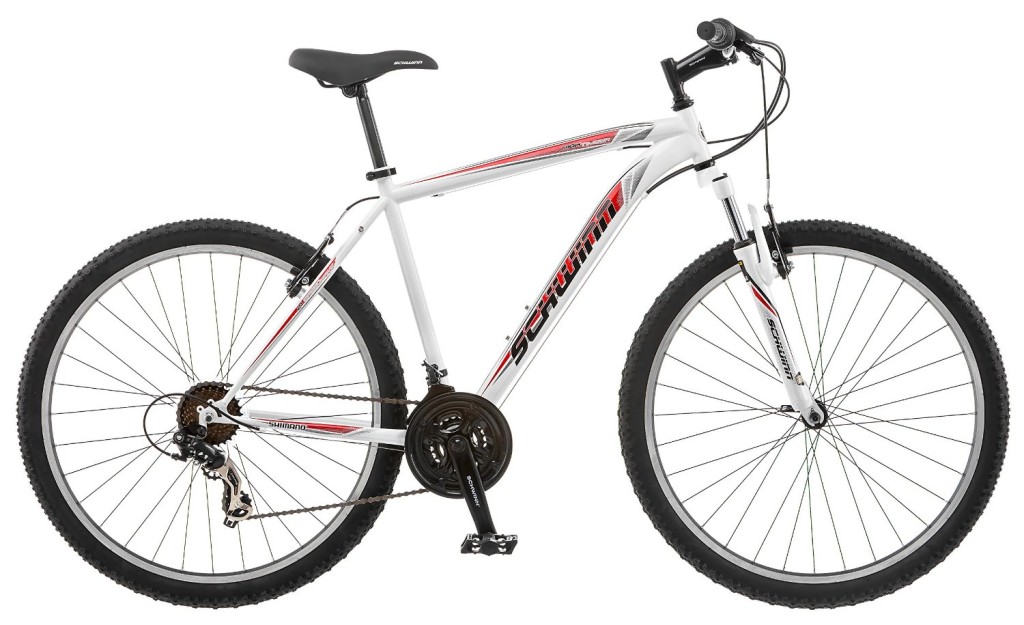
Click here to see the High Timber Best Price
If you’re looking for a mountain bike with less suspension, this High Timber bike by Schwinn is a great offering. Like Diamondback, Schwinn is a trusted and old brand that’s been around for a long time—by purchasing one of their bikes, you know you’ll have it around for years. This bike features Alloy V brakes for sure stops, 21 speeds, and Shimano rear derailleur for the quickest gear changes possible! Users report that this bike is made of nothing but the highest quality parts, and it’s really a deal for the price. If you’re someone planning to ride casually a few times a month, this would be a great bike for you invest in! Users even go so far as to call this bike “perfect” which is quite the compliment, and commuters as well as trail riders alike are really impressed with this product. Schwinn also offers a lifetime-limited warranty, so go forth and buy with confidence!
Thruster KZ2600 Dual-Suspension Mountain Bike (19-Inch Frame) by Thruster
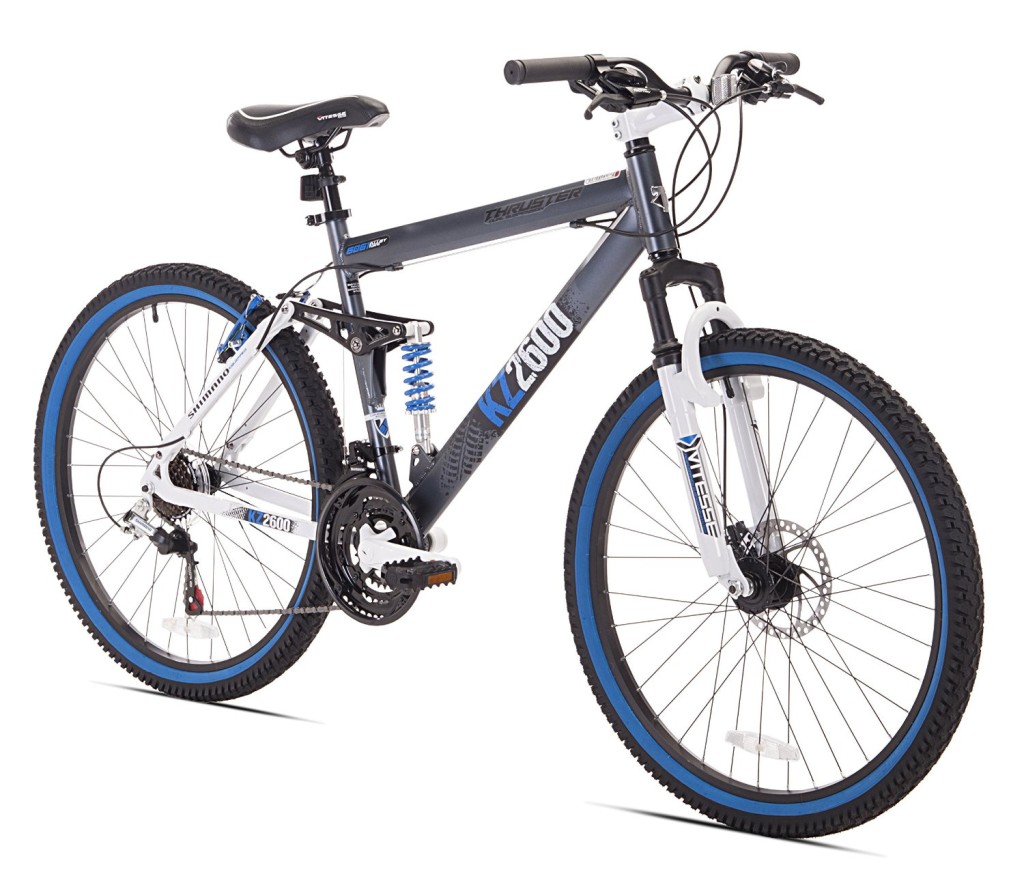
Click here to see the Thruster KZ2600 Best Price
For those of you who are desperately on a budget, the Thruster KZ2600 dual-suspension bike would be a great choice. It features a 26” full-suspension aluminum frame, 21 speeds, and alloy wheel rims. It weighs a solid 40lbs, and is built for lots of rugged adventures. Users report loving this bike for the price, and recommending it for both casual riders and for riders who plan to replace their bike fairly quickly, such as intense trail riders. The seat is slightly uncomfortable, and will need to be replaced or helped with a seat cushion, but aside from that, users can expect to love this bike right out of the box!
So What Now?
It’s easy to imagine how excited you must be, but remember to stay calm and don’t get overwhelmed. You have quite a bit of thinking to do about bikes, and what kind of bike will be best for you. It may be helpful to scan through again, or make a list of the things that are most important to you. You’re obviously not going to buy a dirt bike with no suspension if you suffer from joint pain!
On a final note, it’s not enough to just buy a helmet when you decide to start riding (and don’t start without one!) You’ll need to get a helmet that fits your head properly, which usually entails going to a bike store and having your head measured. Even though it can sound like a tiresome procedure, remember that your helmet is going to keep you safe while riding. Proper helmet use (which includes buckling the strap under your chin!) can save your life, and without it, you’re almost sure to be injured in even a minor bike accident.
So get out there, get shopping, and happy trails! You’re going to love mountain biking; and who knows, you may just start a new trend among your friends!
Leave a Reply